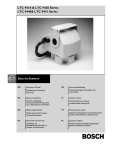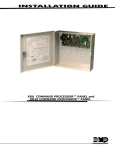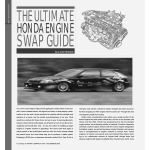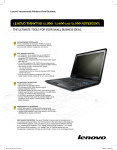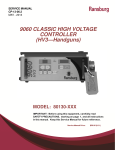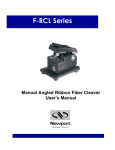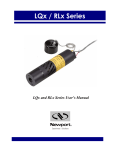Download Bosch LTC 9441 Series Instruction manual
Transcript
LTC 9418 & LTC 9420 Series LTC 9440 & LTC 9441 Series Instruction Manual EN Medium & Heavy Duty Pan Tilts IMPORTANT SAFEGUARDS 12. Power Lines - An outdoor system should not be located in the vicinity of overhead power lines or other electric light or power circuits or where it can fall into such power lines or circuits. When installing an outdoor system, extreme care should be taken to keep from touching such power lines or circuits as contact with them might be fatal. U.S.A. models only - refer to the National Electrical Code Article 820 regarding installation of CATV systems. 13. Overloading - Do not overload outlets and extension cords as this can result in a risk of fire or electric shock. 14. Object and Liquid Entry - Never push objects of any kind into this unit through openings, as they may touch dangerous voltage points or short out parts that could result in a fire or electric shock. Never spill liquid of any kind on the unit. 15. Servicing - Do not attempt to service this unit yourself as opening or removing covers may expose you to dangerous voltage or other hazards. Refer all servicing to qualified service personnel. 16. Damage Requiring Service - Unplug the unit from the outlet and refer servicing to qualified service personnel under the following conditions: a. When the power supply cord or plug is damaged. b. If liquid has been spilled or objects have fallen into the unit. c. If the unit has been exposed to rain or water. d. If the unit does not operate normally by following the operating instructions. Adjust only those controls that are covered by the operating instructions, as an improper adjustment of other controls may result in damage and will often require extensive work by a qualified technician to restore the unit to its normal operation. e. If the unit has been dropped or the cabinet has been damaged. f. When the unit exhibits a distinct change in performance-this indicates a need for service. 17. Replacement Parts - When replacement parts are required, be sure the service technician has used replacement parts specified by the manufacturer or have the same characteristics as the original part. Unauthorized substitutions may result in fire, electric shock, or other hazards. 18. Safety Check - Upon completion of any service or repairs to this unit, ask the service technician to perform safety checks to determine that the unit is in proper operating condition. 19. Coax Grounding - If an outside cable system is connected to the unit, be sure the cable system is grounded. U.S.A. models only--Section 810 of the National Electrical Code, ANSI/NFPA No.70, provides information with respect to proper grounding of the mount and supporting structure, grounding of the coax to a discharge unit, size of grounding conductors, location of discharge unit, connection to grounding electrodes, and requirements for the grounding electrode. 20. Lightning - For added protection of this unit during a lightning storm, or when it is left unattended and unused for long periods of time, unplug it from the wall outlet and disconnect the cable system. This will prevent damage to the unit due to lightning and power line surges. 1. Read Instructions - All safety and operating instructions should be read before the unit is operated. 2. Retain Instructions - The safety and operating instructions should be retained for future reference. 3. Heed Warnings - All warnings on the unit and in the operating instructions should be adhered to. 4. Follow Instructions - All operating and use instructions should be followed. 5. Cleaning - Unplug the unit from the outlet before cleaning. Do not use liquid cleaners or aerosol cleaners. Use a damp cloth for cleaning. 6. Attachments - Do not use attachments not recommended by the product manufacturer as they may cause hazards. 7. Accessories - Do not place this unit on an unstable stand, tripod, bracket, or mount. The unit may fall, causing serious injury to a person and serious damage to the unit. Use only with a stand, tripod, bracket, or mount recommended by the manufacturer or sold with the product. Any mounting of the unit should follow the manufacturer's instructions and should use a mounting accessory recommended by the manufacturer. An appliance and cart combination should be moved with care. Quick stops, excessive force, and uneven surfaces may cause the appliance and cart combination to overturn. 8. Ventilation - Openings in the enclosure, if any, are provided for ventilation, to ensure reliable operation of the unit, and to protect it from overheating. These openings must not be blocked or covered. This unit should not be placed in a builtin installation unless proper ventilation is provided or the manufacturer's instructions have been adhered to. 9. Power Sources - This unit should be operated only from the type of power source indicated on the marking label. If you are not sure of the type of power supply you plan to use, consult your appliance dealer or local power company. For units intended to operate from battery power or other sources, refer to the operating instructions. 10. Grounding or Polarization - This unit may be equipped with a polarized alternating-current line plug (a plug having one blade wider than the other). This plug will fit into the power outlet only one way. This is a safety feature. If you are unable to insert the plug fully into the outlet, try reversing the plug. If the plug should still fail to fit, contact your electrician to replace your obsolete outlet. Do not defeat the safety purpose of the polarized plug. Alternately, this unit may be equipped with a 3-wire grounding-type plug, a plug having a third (grounding) pin. This plug will only fit into a grounding-type power outlet. This is a safety feature. If you are unable to insert the plug into the outlet, contact your electrician to replace your obsolete outlet. Do not defeat the safety purpose of the grounding-type plug. 11. Power Cord Protection - Power supply cords should be routed so that they are not likely to be walked on or pinched by items placed upon or against them, paying particular attention to cords and plugs, convenience receptacles, and the point where they exit from the appliance. 2 SAFETY PRECAUTIONS SICHERHEITSVORKEHRUNGEN CAUTION: TO REDUCE THE RISK OF ELECTRICAL SHOCK VORSICHT: UM EINEN ELEKTRISCHEN DO NOT OPEN COVERS. NO USER SERVICEABLE PARTS SCHLAG ZU VERMEIDEN, ABDECKUNG NICHT ENTFERNEN. INSIDE. WARTUNGEN ALLER ART QUALIFIZIERTEM PERSONAL REFER SERVICING TO QUALIFIED SERVICE PERSONNEL. ÜBERLASSEN. The lightning flash with an arrowhead symbol within an equilateral triangle is intended to alert the user to the presence of uninsulated "dangerous voltage" within the product's enclosure that may be of sufficient magnitude to constitute a risk of electric shock to persons. Das Blitzsymbol im gleichseitigen Dreieck soll den Benutzer auf nicht isolierte "Hochspannung" im Gehäuse aufmerksam machen, die eventuell stark genug ist, um einen elektrischen Schlag zu verursachen. The exclamation point within an equilateral triangle is intended to alert the user to presence of important operating and maintenance (servicing) instructions in the literature accompanying the appliance. Das Ausrufezeichen im gleichseitigen Dreieck soll den Benutzer auf wichtige Bedienungs- und Wartungsanleitungen in der dem Gerät beigefügten Literatur aufmerksam machen. SECURITE PRECAUCIONES DE SEGURIDAD DANGER: POUR ÉVITER TOUT RISQUE PRECAUCION: PARA REDUCIR EL RIESGO DE CHOQUE ELÉCTRICO, FAVOR NO ABRIR LA CUBIERTA. ESTE EQUIPO NO CONSTA DE PIEZAS O PARTES QUE REQUIEREN SERVICIO O MANTENIMIENTO. PARA REPARACIONES FAVOR REFERIRSE A UN TÉCNICO CALIFICADO. D'ÉLECTROCUTION, NE PAS OUVRIR LE BOÎTIER. IL N'Y A PAS DE PIÈCES REMPLAÇABLES À L'INTÉRIEUR. POUR TOUTE RÉVISION, S'ADRESSER À UN TECHNICIEN SPÉCIALISÉ. L'éclair fléché dans un triangle équilatéral, avertit l'utilisateur de la présence d'une "tension dangereuse" non isolée à l'intérieur de l'appareil et d'une valeur suffisante pour constituer un risque d'électrocution. El símbolo representado por un relámpago con punta de flecha dentro de un triángulo equilátero, se muestra con el objetivo de alertar al usuario que existen "voltages peligrosos" sin aislamiento, dentro de la cubierta de la unidad. Dichos voltages pueden ser de tal magnitud que constituyen un riesgo de choque eléctrico a personas. Le point d'exclamation contenu dans un triangle équilatéral, avertit l'utilisateur de la présence, dans la documentation qui accompagne l'appareil, de consignes d'utilisation et de maintenance importantes. El símbolo de exclamación dentro de un triángulo equilátero, se muestra con el objetivo de alertar al ususario de que instrucciones de operación y mantenimiento importantes acompañan al equipo. 3 CONTENTS 1 2 3 3.1 3.2 3.3 3.4 3.5 3.6 3.7 3.8 4 4.1 4.2 4.3 4.4 4.5 4.6 5 6 7 Unpacking . . . . . . . . . . . . . . . . . . . . . . . . . . . . . . . . . . . . .4 Service . . . . . . . . . . . . . . . . . . . . . . . . . . . . . . . . . . . . . . . .4 INSTALLATION . . . . . . . . . . . . . . . . . . . . . . . . . . . . . . . . .5 Model Designation . . . . . . . . . . . . . . . . . . . . . . . . . . . . . . .5 Recommended Mounting Equipment . . . . . . . . . . . . . . . . . . .5 Wall Mounting . . . . . . . . . . . . . . . . . . . . . . . . . . . . . . . . . .5 Camera/Lens/Enclosure Mounting . . . . . . . . . . . . . . . . . . . . .5 Electrical Connections . . . . . . . . . . . . . . . . . . . . . . . . . . . . .6 Grounding Connection . . . . . . . . . . . . . . . . . . . . . . . . . . . .6 Connector Assembly . . . . . . . . . . . . . . . . . . . . . . . . . . . . . .6 Pan Stops (345° Models) . . . . . . . . . . . . . . . . . . . . . . . . . . .8 OPERATION . . . . . . . . . . . . . . . . . . . . . . . . . . . . . . . . . . .8 Manual Pan Operation (345° Models) . . . . . . . . . . . . . . . . .8 Auto-Pan Operation (345º Models) . . . . . . . . . . . . . . . . . . .8 Pan Stop Adjustment (345° Models) . . . . . . . . . . . . . . . . . .8 Pan Operation (360° Models) . . . . . . . . . . . . . . . . . . . . . . .8 Tilt Stop Adjustment (All Models) . . . . . . . . . . . . . . . . . . . .9 Pre-Position Models . . . . . . . . . . . . . . . . . . . . . . . . . . . . . .9 WIRING DIAGRAMS . . . . . . . . . . . . . . . . . . . . . . . . . . . .10 RECOMMENDED APPLICATIONS . . . . . . . . . . . . . . . . .13 DIMENSIONAL OUTLINE . . . . . . . . . . . . . . . . . . . . . . . .13 1 UNPACKING 2 SERVICE This electro-mechanical equipment should be unpacked carefully and handled with care. If the unit ever needs repair service, the customer should contact the nearest Bosch Security Systems, Inc. Service Center for authorization to return and shipping instructions. Check for the following items: • Model number of unit. • 3/32-inch Allen wrench. • Connector Kit 315 1232 001 Service Centers If an item appears to have been damaged in shipment, replace it properly in its carton and notify the shipper. If any items are missing, notify Bosch Security Systems. U.S.A.: 800-366-2283 or 408-956-3895 Fax: 800-366-1329 or 408-956-3896 Email: [email protected] Canada: 514-738-2434 Europe, Middle East & Asia Pacific Regions 800-366-2283 The shipping carton is the safest container in which the unit may be transported. Save it for possible future use. For additional information, see www.boschsecuritysystems.com 4 3 INSTALLATION CAUTION: DO NOT EXCEED 30 VAC INPUT ON 24 VAC MODELS. OPERATION ABOVE 30 VAC VIOLATES LOW VOLTAGE OPERATION (CLASS 2 SPECIFICATIONS). NORMAL OPERATION IS 24 VAC. CUL APPROVED 24 VAC MODELS. THIS INSTALLATION SHOULD BE MADE BY A QUALIFIED SERVICE PERSON AND CONFORM TO ALL LOCAL CODES. CAUTION: CONNECT TO CLASS 2 POWER SUPPLY ONLY. TOTAL CURRENT THROUGH ELECTRICAL CONNECTOR IS 4 A MAXIMUM. PAN/TILT CURRENT IS 1 A MAXIMUM. ALLOWABLE CAMERA/HOUSING IS 3 A MAXIMUM. USE ONLY 24 VAC CAMERAS AND HOUSINGS ON FEED-THRU MODELS. ALWAYS DISCONNECT POWER TO UNIT AT CONTROLLER PRIOR TO CONNECTING OR DISCONNECTING PAN/TILT ELECTRICAL CONNECTOR. PAN/TILT TO BE MOUNTED AWAY FROM UNAUTHORIZED ACCESS [3 METERS (10 FEET) HIGH MINIMUM] THESE UNITS ARE DESIGNED FOR EITHER UPRIGHT OR INVERTED INSTALLATIONS. TO MAINTAIN WEATHERPROOF INTEGRITY WHEN MOUNTING OUTDOORS IN AN INVERTED POSITION, THE UNIT MUST BE INSTALLED IN A WEATHERPROOF ENCLOSURE (E.G., WEATHERPROOF DOMED HOUSING) OR A PROTECTED OUTSIDE AREA. Pan/tilts and associated equipment should be tested prior to field installation to verify proper wiring and operation of components. LTC 9418 & LTC 9420 The maximum load is 10kg (22lb) or 149kg-cm (129lb-in) torque at a distance of 63.5mm (2.5in) from the center of mass of the camera/lens/housing assembly to the center of the tilt table. 3.2 Recommended Mounting Equipment LTC 9216/00 Medium duty wall mount designed to support up to 45.3kg (100lb). LTC 9222/00 Heavy duty wall mount designed to support up to 90.6kg (200lb). LTC 9214/00 Heavy duty 336mm (14 inch) column mount for ceiling or pedestal. LTC 9224/00 Heavy duty 610mm (24 inch) column mount for ceiling or pedestal use. 3.3 Wall Mounting Follow the instructions provided with mounts. Mount and mounting surface must be able to support the weight of the pan/tilt, camera/lens, and enclosure (if used). The camera/lens/enclosure must be properly mounted and balanced on the pan/tilt bracket. LTC 9440 & LTC 9441 The maximun load is 18kg (40lb) or 297kg-cm (260lb-in) torque with center of mass located 3.12in (79.2mm) from the center of the titl table. The combined weight of the enclosure/camera/lens should be centered equally, front to back, on the tilt table surface for best pan/tilt operation. 3.4 Camera/Lens/Enclosure Mounting Mount the camera/lens/enclosure to the pan/tilt bracket as follows: SEE RECOMMENDED APPLICATIONS. 1. 3.1 CAUTION: THE PAN/TILTS IN THIS MANUAL CAN ONLY BE MOUNTED UPRIGHT OR INVERTED; NEVER HORIZONTALLY. Model Designation LTC 9418 Series Load Rating: 22lb Load (10Kg), 129lb-in (149kg-cm) torque Wiring: Standard Power Required: 24W LTC 9420 Series Load Rating: 22lb Load (10Kg), 129lb-in (149kg-cm) torque Wiring: Feed-thru Power Required: 24W LTC 9440 Series Load Rating: 40lb Load (18kg), 260lb-in (297kg-cm) torque Wiring: Standard Power Required: 20W LTC 9441 Series Load Rating: 40lb Load (18kg), 260lb-in (297kg-cm) torque Wiring: Feed-thru Power Required: 20W /60 models*: /20 models*: * 40lb Models /10 models: /50 models: Rated Motor Voltage Voltage Range 120VAC, 60Hz 24VAC, 60Hz 108 to 132 21.6 to 26.4 24VAC, 60Hz 23 to 26.4 24VAC, 50Hz 220VAC, 50Hz 21.6 to 26.4 207 to 253 2. Balance the camera/lens/enclosure and adjust the unit to align with mounting holes. Fasten with a minimum of two (2) 1/4-20 x 1/2-inch long fasteners and lock washers. Make all electrical connections. Leave sufficient loops of cable between camera/enclosure and pan/tilt to allow for tilting and panning. Pan Range: 00 to 3450 on standard models, 00 to 3600 on Continuous Pan models. Pre-position is designated as -/x1, e.g., LTC 9441/61 5 3.5 Electrical Connections 1. Cable must be wired according to Connector Assembly (Section 3.7) and Recommended Maximum Cable Lengths (Table 1). 2. Use separate shielded cables for camera power, enclosure power, and pan/tilt control. If required, combining lens control wiring and video coax within a common cable is acceptable. The use of a common multiconductor cable to combine all functions is not recommended. 3. Use color coded conductors to aid wiring and future identification. 4. Retain wiring diagram for later reference. Model Voltage Wire Size mm2 AWG Distance1 Feet Meters 24 VAC2 0.5 1 1.5 2.5 4 0.5 1 1.5 2.5 0.5 1 1.5 2.5 140 230 360 590 940 2200 3500 5500 9000 13400 21200 33300 54400 110 VAC 220 VAC Table 1 20 18 16 14 12 20 18 16 14 20 18 16 14 43 70 110 180 287 671 1067 1677 2744 4085 6463 10152 16585 CAUTION: CONTACT REMOVAL FROM CONNECTOR REQUIRES USE OF AMP #305183 EXTRACTION TOOL. 3.6 Grounding Connection A ground screw is located on the base to the right of connector. See Figure 8. Connect a 1 mm2 (No.18 AWG) ground wire to the nearest earth ground. 3.7 Connector Assembly A mating connector, sockets and a strain relief are included with the unit. Refer to Figure 1. To install, select the appropriate size strain relief clamp. Choose one of the two strain relief clamps enclosed with the sleeve and the extender. The clamping area is adjustable by inverting or changing the strain relief clamps. Discard the four strain reliefs on the carrier strip packaged with the shield. Insert the clamp into the strain relief until it bottoms. The clamp should bottom on the wire bundle, not on the shield’s shoulder. If the wire diameter is too small, temporarily wrap the wire with electrical tape until proper clamping is obtained. Secure the clamp with the two (2) screws provided. CAUTION: MAKE SURE THE WIRE BUNDLE IS PROPERLY SECURED. DO NOT PINCH THE WIRES. Maximum Cable Lengths Notes For Table 1 1. Values calculated at 20º C (68 ºF) using stranded tinned copper wire, a common ground (neutral), and both PAN and TILT motors operating simultaneously. 2. For 24 VAC Models operating at or near -30º C, values are based upon maintaining the supplied voltage within the voltage range as specified in Section 3.1. Screws (2) AMP Hand Crimping Tool #58495-1 is recommended for crimping sockets. Refer to Figure 2 for the numbered connector positions.The connector will accept up to a #16 AWG wire. If heavier gauge wire is required, pigtailing according to local electrical codes is recommended. Strain Relief Clamp Strain Relief Slot Shield Washer Wire Bundle Strip Length .156 ± .015 Sleeve Contact Extender Connector Figure 1: Shield/Strain Relief Assembly 6 WIRE DESIGNATION AND PIN CONNECTIONS Figure 2: Pin Outs 345° Non-Pre-Position Models5,6 Feed -thru Wiring Pin 1: 2: 3: 4: 5: 6: 7: 8: 9: 10: 11: 12: 13: 14: 15: 16: 17: 18: 19: 20: 21: 22: 23: 24: Number NC1 NC1 NC1 NC1 Lens Common Zoom Focus Unused Unused Accessory Accessory Accessory NC1 NC1 NC1 Pan Left NC1 Pan Right P/T Common Tilt Up Tilt Down Ground Camera AC-Line Camera AC-Neutral Color Green2 Blue2 Violet2 Brown2 Black2 White2,3 Red2,3 Yellow2,3 White Violet Blue Brown White/Yellow Green/Yellow2 Black2,4 White2,4 345° Pre-Position Models5,6 Feed-thru Wiring Pin 1: 2: 3: 4: 5: 6: 7: 8: 9: 10: 11: 12: 13: 14: 15: 16: 17: 18: 19: 20: 21: 22: 23: 24: Number PP Supply (+) Pan Position PP Return (-) Tilt Position Lens Common Zoom Focus Zoom Position Focus Position Accessory Accessory Accessory NC1 NC1 NC1 Pan Left NC1 Pan Right P/T Common Tilt Up Tilt Down Ground Camera AC-Line Camera AC-Neutral Color Orange2 Yellow2 Gray2 White/Black2 Green2 Blue2 Violet2 Brown2 Black2 White2,3 Red2,3 Yellow2,3 White Violet Blue Brown White/Yellow Green/Yellow2 Black2,4 White2,4 345° Non-Pre-Position Models5,6 Standard Wiring Pin Number 1: NC1 2: NC1 3: NC1 4: NC1 5: NC1 6: NC1 7: NC1 8: NC1 9: NC1 10. NC1 11. NC1 12. NC1 13: NC1 14: NC1 15: NC1 16: Pan Left 17: NC1 18: Pan Right 19: P/T Common 20: Tilt Up 21: Tilt Down 22: Ground 23: NC1 24: NC1 Color White Violet Blue Brown White/Yellow Green/Yellow2 345° Pre-Position Models5,6 Standard Wiring Pin Number 1: PP Supply (+) 2: Pan Position 3: PP Return (-) 4: Tilt Position 5: NC1 6: NC1 7: NC1 8: NC1 9: NC1 10. NC1 11. NC1 12. NC1 13: NC1 14: NC1 15: NC1 16: Pan Left 17: NC1 18: Pan Right 19: P/T Common 20: Tilt Up 21: Tilt Down 22: Ground 23: NC1 24: NC1 Color Orange2 Yellow2 Gray2 White/Black2 White Violet Blue Brown White/Yellow Green/Yellow2 7 360° Pre-Positions and Non Pre-position Models7,8 Pin Number 1: Pan +5V 2: Pan Sense (3) 3: Pan-5V 4: Tilt Sense 5: Lens Common 6: Zoom 7: Focus 8: NC1 9: NC1 10. Accessory 11. Accessory 12. Accessory 13: NC1 14: NC1 15: Pan Sense (2) 16: Pan Left 17: NC1 18: Pan Right 19: P/T Common 20: Tilt Up 21: Tilt Down 22: Ground 23: Camera AC-Line 24: Camera AC-Neutral Color Orange8 Wht/Blk/Yel8 Wht/Blk/Red8 Wht/Blk/Brn8 Green2 Blue2 Violet2 White2,3 Red2,3 Yellow2,3 White/Orange8 White Violet Blue Brown White/Yellow Green/Yellow2 Black2,4 White2,4 Notes 1. NC -- No Connection, do not use. 2. (Color Codes) indicate feed-thru wiring to camera/housing. 3. Apply to 24 volt models only. Pins 10 thru 12 are not used in 110 volt or 220 volt models. 4. (Color Codes) shown are for 24 volt, 60 HZ and 110 volts models. For 220 volt and 24 volt, 50 HZ models, color codes are (23) Brown, and (24) Blue. 5. The conductors for pins 16 thru 24 (where applicable) on 220 volt models should be isolated from other wiring with reinforced insulation requirements of DIN VDE 0860/05.89, IEC 65. The conductors for pins 16 thru 24 (where applicable) must be in HAR cord minimum cross sectional area 0.75 mm2 (H05 VV-F). 6. Refer to Figure 6 for the wiring schematic. 7. Refer to Figure 7 for the wiring schematic. 8. Pre-Position models only. Refer to Figure 8 for the wiring schematic. 3.8 Pan Stops (345° Models) Locate the three (3) limit stops on the base of the unit. The red limit stop is the Fixed Stop. It is not adjustable and should not be removed. The remaining two (2) stops are called Pan Stops. These are positioned on each side of the pan switch lever. The two (2) pan stops are adjustable and secured with a set screw. The screws can be accessed through the hole in the end of each stop. Use a 3/32-inch Allen wrench (supplied) to loosen and tighten the set screw. See Figure 3. 4.2 Auto-Pan Operation (345º Models) Use of the auto-pan function requires wiring connections to pin 16 (Pan Left), pin 18 (Pan Right), and pin 19 (Common). See Figure 6. The auto-pan function is achieved by the controller unit sensing changes in current flow through the pan motor. When a pan stop is reached, the current flow stops and internal circuitry of the controller unit reverses the auto-pan direction. Note: The pan/tilt controller must be equipped with special current sensing circuitry to operate the auto-pan function in this mode. The pan stops or the fixed stop establish the limits for auto-pan. Top View Of Base Front Top View Of Base Front Left (CCW) Pan Stops Right (CW) Fixed Stop (Red) Pan Stops Removed Rear Fixed Stop (Red) Figure 3: Pan Stop Locations (345º Models) Figure 4: Maximum Manual Pan and Maximum Auto-Pan (345º Models) 4 OPERATION 4.1 4.3 Manual Pan Operation (345° Models) The pan stops establish the limits for manual pan. The two (2) adjustable pan stops may be repositioned or removed depending on the desired operation. The maximum pan range setup is shown in Figure 4. CAUTION: NEVER MOVE OR REMOVE THE FIXED STOP. IT MUST ALWAYS BE IN PLACE FOR PROPER OPERATION OF THE PAN FUNCTION. 1. 2. 3. Pan Stop Adjustment (345° Models) Loosen the pan stops and adjust to the desired range for manual pan and auto-pan. A recessed area in the pan head allows enough clearance to remove a stop from the base. When all the stops are in place, check to see that they are secure. Operate the unit from the controller to confirm that the limits are set properly. Readjust if required. 4.4 Pan Operation (360° Models) These models allow 360 degree rotational (pan) operation. They have no pan stops. These units can be manually panned left or right or they can be panned continuously left or right by auto-pan activation. Auto-Pan activation requires wiring connections to pin 16 (Pan Left), pin 18 (Pan Right), and pin 19 (Common). See Figure 7. 8 4.5 Tilt Stop Adjustment (All Models) After the unit is installed and all wire connections are made, apply proper power to the control unit. Refer to Figure 5, and adjust the tilt stops as follows: 1. 2. 3. 4. With the front of the pan/tilt facing you, remove the left hub cap. The tilt stop adjustment screws are now exposed. Using the control unit, tilt the bracket up to the desired position and stop the unit. Use the 3/32-inch Allen wrench to loosen the Tilt Up stop. Slide the stop Up until a faint click is heard (indicating switch actuation). Tighten the Tilt Up limit stop screw. Using the control unit, tilt the bracket to the desired position and stop the unit. Use the 3/32-inch Allen wrench to loosen the Tilt Down stop. Slide the stop Down until a faint click is heard. Tighten the Tilt Down limit stop screw. Operate the control unit to verify proper tilt stop range and operation. Repeat above sequence if necessary. Make certain both tilt stop screws are snug. Replace the hub cap. CAUTION: DO NOT OPERATE PAN/TILT UNIT WITHOUT STOPS. LIMIT STOPS SHOULD NOT BE ADJUSTED WHILE UNIT IS OPERATING. REAR Tilt Down (CW) Stop FRONT Tilt Up (CCW) Stop Figure 5: Tilt Stops (Side View - Plug Removed) 4.6 Pre-Position Models The 345° models with pre-position capability require wiring connections to pins 1 through 4, 8 and 9, and use of a controller or receiver/driver with the pre-position function. Pan and tilt operation and limit stop adjustments function the same as the previous models described. 9 5 WIRING DIAGRAMS Figure 6: Wiring Diagram - 0º to 345º Models 10 Video Figure 7: Wiring Diagram - 360º Models 11 Video Control Figure 8 - 360º Models with Pre-Position 12 6 RECOMMENDED APPLICATIONS 360° Models Only Feed-thru 24 Volt Models USE ONLY 24 VOLT CAMERAS/HOUSINGS WITH 360° MODEL PAN/TILTS. TO MAINTAIN CUL AND TUV APPROVAL, USE ONLY 24 VOLT CAMERAS/HOUSINGS. THE MAXIMUM POWER FOR HEATER/BLOWER COMBINATIONS IS 75 WATTS TO PREVENT OVERLOADING THE SLIP RING. THIS LOAD MUST BE POWERED BY PIN 10, (WHITE FEED-THRU) AND PIN 11 (RED FEED-THRU). SEE FIGURE 2. 7 DIMENSIONAL OUTLINE Figure 9 13 This page intentionally left blank 14 This page intentionally left blank 15 Bosch Security Systems, Inc. 850 Greenfield Road Lancaster, PA 17601 EE.UU. Tel: 800-326-3270 Fax: 717-735-6560 www.boschsecuritysystems.com Robert Bosch GmbH Geschäftsbereich Postfach 10 60 50 70049 Stuttgart Telefax (0711) 811-1234 @ 2003 Bosch Security Systems GmbH 100 0083 001 BOS 08/03 Data subject to change without notice. Bosch Security Systems B.V. P.O. Box 80002 5600 JB Eindhoven The Netherlands Tele +31 40 27 80000
















